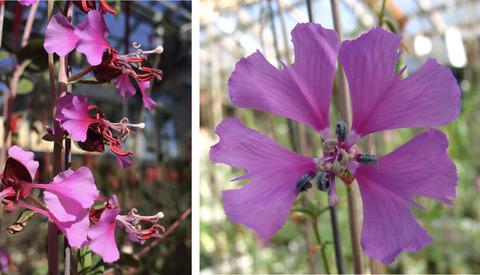Our official English website, www.x-mol.net, welcomes your
feedback! (Note: you will need to create a separate account there.)
Mating system and historical climate conditions affect population mean seed mass: Evidence for adaptation and a new component of the selfing syndrome in Clarkia
Journal of Ecology ( IF 5.3 ) Pub Date : 2019-12-05 , DOI: 10.1111/1365-2745.13338 Susan J. Mazer 1 , Isaac M. Park 1 , Matthew Kimura 1 , Emma M. Maul 1 , Aaron M. Yim 1 , Kristen Peach 1
中文翻译:

交配系统和历史气候条件影响种群的平均种子质量:适应性证据和克拉克自治州自交综合征的新组成部分
更新日期:2019-12-05
Journal of Ecology ( IF 5.3 ) Pub Date : 2019-12-05 , DOI: 10.1111/1365-2745.13338 Susan J. Mazer 1 , Isaac M. Park 1 , Matthew Kimura 1 , Emma M. Maul 1 , Aaron M. Yim 1 , Kristen Peach 1
Affiliation

|
- The evolution of seed size may be influenced by intrinsic attributes of populations, such as mating system and extrinsic factors, such as climate. Several hypotheses propose that the evolution of self‐fertilization from an outcrossing progenitor will be accompanied by a reduction in seed size, but this prediction has not been rigorously tested. Many studies report that the mean seed size of populations or taxa is associated with long‐term climate conditions. Here, we examined the effects on seed size of both mating system and climate within a single genus.
- In the California wildflower genus, Clarkia (Onagraceae), we sampled seeds from 58 populations representing three pairs of sister taxa; each pair included a predominantly outcrossing and a facultatively selfing taxon. We then examined the independent effects on population mean seed size of mating system, elevation, long‐term (30‐year) climate conditions, and climate anomalies (the deviation between conditions in the year of collection and the long‐term mean), focusing on maximum monthly temperature (T max), cumulative moisture deficit and cumulative precipitation (PPT) during Clarkia's growing season (fall, winter and spring).
- In each taxon pair, the selfing taxon had smaller seeds than the outcrosser. Local, long‐term (1921–1980 and 1981–2000) mean T max, PPT and elevation were independently and negatively associated with seed size. Long‐term means for T max and PPT explain geographical variation in seed size better than climate anomalies in the year of collection.
- Synthesis . We corroborated two key hypotheses concerning the drivers of geographical variation in mean seed size. Small seeds in Clarkia co‐evolve with selfing (although the mechanism remains elusive) and in response to chronically warm and wet conditions. The effect of long‐term mean precipitation on seed size differs qualitatively from the effect of precipitation anomalies; relatively large seeds are produced in populations experiencing wetter‐than‐normal years. Ongoing climate change may therefore generate conflicting selection on seed size in Clarkia : intensifying drought is likely to lead to an evolutionary increase in seed size due to its effects on seedling survivorship, while climate‐driven declines in pollinators or selection favouring more rapid reproduction may promote the evolution of self‐pollination, facilitating the evolution of smaller seeds.
中文翻译:

交配系统和历史气候条件影响种群的平均种子质量:适应性证据和克拉克自治州自交综合征的新组成部分
- 种子大小的演变可能会受到种群的内在属性(例如交配系统)和外部因素(例如气候)的影响。一些假设提出异种祖先自我受精的进化将伴随着种子大小的减小,但是这一预测还没有经过严格的检验。许多研究报告说,种群或分类单元的平均种子大小与长期气候条件有关。在这里,我们研究了单一属对交配系统种子大小和气候的影响。
- 在加利福尼亚州的野花属克拉克(Onagraceae)中,我们从代表三对姊妹类群的58个种群中抽取了种子。每对包括一个主要的杂交和一个自交系的分类单元。然后,我们研究了对交配系统种群平均种子大小,海拔,长期(30年)气候条件和气候异常(采集年份条件与长期平均值之间的偏差)的独立影响,在Clarkia生长季节(秋季,冬季和春季)的最高月温度(T max),累积水分亏缺和累积降水(PPT )方面。
- 在每个分类单元对中,自交分类单元的种子均比异型杂交的种子小。局部,长期(1921–1980年和1981–2000年)平均T max,PPT和海拔高度与种子大小无关,且呈负相关。T max和PPT的长期平均值解释了种子大小的地理差异,优于收集年份的气候异常。
- 综合。我们证实了有关平均种子大小地理变异的驱动因素的两个关键假设。Clarkia中的小种子与自交共同进化(尽管机理仍然难以捉摸),并响应于长期温暖和潮湿的条件。长期平均降水量对种子大小的影响与降水异常的影响在质量上有差异。在比正常年份多的年份中,人们会产生相对较大的种子。因此,持续不断的气候变化可能会在克拉克的种子大小上产生矛盾的选择。:由于干旱对种子存活的影响,加剧的干旱可能导致种子大小的进化增加,而气候驱动的传粉媒介减少或有利于更快繁殖的选择可能促进自花授粉的进化,从而促进较小种子的进化。











































 京公网安备 11010802027423号
京公网安备 11010802027423号